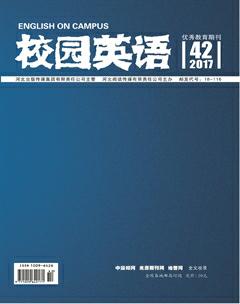A Brief Analysis of the Self—correction Model
She+Ali
【Abstract】This paper proposes a new teaching model and explains it from the perspective of constructivism in psychology .
【Key words】constructivism; self-correction model
1. Introduction
There are many theories about the second language acquisition(SLA), but most of them are based on the Indo-European languages. This paper puts forward a new teaching model and explains it from the perspective of constructivism in psychology.
2. The concept of the Self- correction Model
This “Self-correction Model” can be divided into the following six steps. Step 1, translating. The learner translates the native language into the target language. Step 2, comparing. the learner compares the learners language with the target language to find out the differences. Step 3, analyzing. The learner analyzes the causes of these differences. Step 4, correcting. The learner corrects the differences or error places according to the rules and forms of the target language. Step 5, memorizing. The learner abandons the error sentences and keeps the correct sentences of the target language in mind. Step 6, reproducing. The learner uses the correct sentences of the target language in other similar situations.
3. The Constructivism and the Self- correction Model
Constructivism is the further development of cognism.(Zhang, 2011) The theory of constructivism is rich in contents, but its core can be summed upin the following sentence, that is, its student-centered and it emphasizes active exploration, active reflection and active construction to knowledge. It is unlike the traditional teaching, whose core is to transfer knowledge from teachers mind to students notebooks. Constructivism is student-centered and its emphasis is “learning”. (Hong, 2011)
Constructivists believe that the world is an objective existence, but understanding the world and giving meaning to the world are decided by individuals. We construct reality based on our own experiences or at least interpretating the reality. Everyones experience world is created in his own mind. Because of different experiences and beliefs, people understand the outside world differently. Therefore, learning is not simply transferring knowledge to students, but its the process of constructing their own knowledge. Students do not simply accept the information passively but construct knowledge and meaning actively and this kind of construction is not to be replaced by others. (Guo&Ou, 2010)endprint
The learning process includes the construction of two aspects:one is to construct the meaning of new information, and at the same time it contains reform and reconstructure to the original experience, which is in accordance with the mutual construction of Piagets assimilation and accommodation. But constructivists pay more attention to the later construction and emphasizes that the schema developed in the learning process is not a fixed one. On the contrary, it is a new one with full understanding and background information. So when facing the new situation, they can construct the schema to guide the activities flexibly.
Learning and understanding any subject is not like painting on white paper. Learning always involves the original cognitive structure of learners. Learners are always in their own experience, including informal learning before formal learning and daily concepts before scientific concepts, to construct new knowledge and information. That is, learning is not accepting the information passively but constructing actively. The learner selects, processes and handles actively to get the meaning according to his own experience. The external information itself is not meaningful. The meanging is constructed through repeated interaction, two-way function between the old and new knowledge. Therefore, learning behavior is not like the behavioristic view “stimulus and response”. The obtaining of learning is the learners reunderstanding and encoding based on their own existing knowledge and experience. In this process, the learners original knowledge and experience adjust and change because of the entering of new knowledge. Therefore, constructivists pay attention to constructing knowledge with the original experience, psychological structure and beliefs.
Conclusion
In the process of self-correction Model, it requires the students to finish the learning with the help of computers, network and dictionary by themselves. The teacher is no longer the initiater of knowledge, but the helper, even senior partner. The role of teachers is to guide students to understand:“The way of getting knowledge is to internalize them through comparing and colliding between old knowledge and new knowledge. In this process, the students rely on themselves. The teacher can only help, but not replace.” (Chen, 2006) The self-correction Model always puts the students in the main place and educate the students, guide the students to obtain the knowledge by themselves. Its pefect in accordance with the constructivism.
References:
[1]洪顯利.教育心理学的经典理论及应用[M].北京:北京大学出版社,2011.endprint

